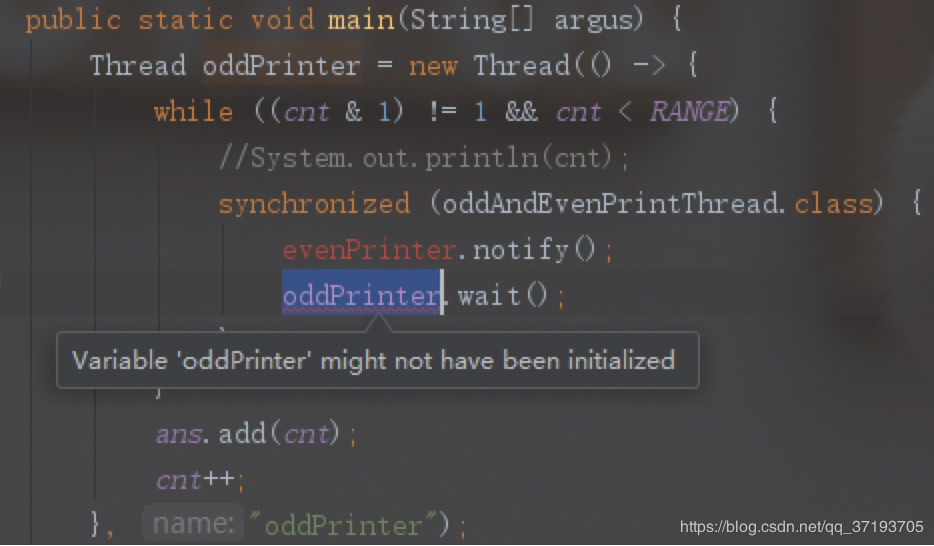练手——蚂蚁二面笔试题 1. 起两个线程,交替打印奇数和偶数 一拿到这个题目有几个思路,1.共享变量,2.等待/通知机制,其实感觉考察的是进程通信的方式(6种)
共享变量实现如下:
public class oddAndEvenPrintThread public static int cnt = 0 ; public static final int RANGE = 1000 ; public static List<Integer> ans = new ArrayList<>(RANGE); public static void main (String[] argus) Thread oddPrinter = new Thread(() -> { while (cnt < RANGE) { if ((cnt & 1 ) == 1 ) { ans.add(cnt); cnt++; } } }, "oddPrinter" ); Thread evenPrinter = new Thread(() -> { while (cnt < RANGE) { if ((cnt & 1 ) == 0 ) { ans.add(cnt); cnt++; } } }, "evenPrinter" ); try { oddPrinter.start(); evenPrinter.start(); oddPrinter.join(); evenPrinter.join(); } catch (Exception e) { e.printStackTrace(); } ans.forEach((a) -> System.out.print(a + " " )); } }
其实这里可以有几个优化的地方,1.用线程池代替单独的线程;2.当不满足cnt条件时可以加一个yield主动放弃cpu资源(这个见仁见智,我觉得没必要,多核cpu还会增加上下文切换的开销)
用线程池又写了一个版本:(此处如果面试还能再阐述下线程池的几个好处,绝对的加分项)
public class oddAndEvenPrintThread public static int cnt = 0 ; public static final int RANGE = 1000 ; public static List<Integer> ans = new ArrayList<>(RANGE); public static final ExecutorService oddExecutorService = new ThreadPoolExecutor(1 ,1 ,60L , TimeUnit.SECONDS,new LinkedBlockingQueue<>()); public static final ExecutorService evenExecutorService = new ThreadPoolExecutor(1 ,1 ,60L , TimeUnit.SECONDS,new LinkedBlockingQueue<>()); public static void main (String[] argus) Future oddTask = oddExecutorService.submit(() -> { while (cnt < RANGE) { if ((cnt & 1 ) == 1 ) { ans.add(cnt); cnt++; } } }); Future evenTask = evenExecutorService.submit(() -> { while (cnt < RANGE) { if ((cnt & 1 ) == 0 ) { ans.add(cnt); cnt++; } } }); try { oddTask.get(); evenTask.get(); } catch (Exception e) { e.printStackTrace(); } ans.forEach((a) -> System.out.print(a + " " )); } }
这里需要用submit代替execute,原因是submit的任务可以拿到Future的一个返回值,在主线程中我们可以通过futureTask.get操作获取到返回的结果值,若果任务未执行完则会阻塞
之后的第二个思路,用wait()和notify()实现,这个版本由于涉及到synchronize加锁效率较低,同时写的时候出现了下面的问题:
说明在自己线程里面,不能对自己去wait,而且此时去通知evenPrinter线程,会由于该线程定义的顺序关系无法运行,固需要换个思路在主线程里去做通知和等待,而这两个线程仅负责打印奇数和偶数,不做其他的判断(相当于把判断当前哪个线程打数字的工作交给了主线程),理清了思路不难发现写起来真的很麻烦,同时判断打奇数和偶数还要通过一个变量cnt去记录,那为什么不直接采用第一个版本呢?这个实现显然多此一举。
2.实现一个带超时时间的队列,队列中会自动剔除超时的数据 一个思路就是用一个linkedlist 作为队列的载体,再加上一个timer或者起一个线程去每隔几秒删除过期数据
此处直接用第一个思路实现,同时考虑到多线程环境(加分项),对相关方法做同步操作。
用timer或者thread去写大同小异:
public class QueueWithTimeOut private LinkedList<Node> que; private Timer timer; private int size; private int curSize = 0 ; QueueWithTimeOut(int size, int delay, int interval) { this .size = size; this .que = new LinkedList(); this .timer = new Timer(); Thread thread = new Thread(() -> { try { Thread.sleep(delay); } catch (Exception e) { e.printStackTrace(); } while (true ) { try { scanAndDelete(); Thread.sleep(interval); } catch (Exception e) { e.printStackTrace(); } } }, "scanThread" ); thread.start(); } public class Node Object key; long timeout; Node(Object key, long timeout) { this .key = key; this .timeout = timeout; } public long getTimeout () return timeout; } } public synchronized void offer (Object key, long currentTime, long timeout) throws Exception timeout += currentTime; if (curSize > size) throw new Exception("size 已满" ); Node node = new Node(key, timeout); que.offer(node); curSize++; } public synchronized Object poll () if (!que.isEmpty()) return que.poll(); else return null ; } private synchronized void scanAndDelete () if (!que.isEmpty()) { int len = que.size(); for (int i = 0 ;i<len;i++) { if (que.get(i).getTimeout() < getCurrentTime()) que.remove(i); } } else return ; } private long getCurrentTime () return System.currentTimeMillis(); } }
由于考虑到多线程,在方法里加了synchronized,性能并不高,更好的实现是用读写锁去优化,改写后的offer,poll,scanAndDelete方法如下:
private ReentrantReadWriteLock rwlock = new ReentrantReadWriteLock();public void offer (Object key, long currentTime, long timeout) throws Exception timeout += currentTime; if (curSize > size) throw new Exception("size 已满" ); rwlock.writeLock().lock(); Node node = new Node(key, timeout); que.offer(node); curSize++; rwlock.writeLock().unlock(); } public synchronized Object poll () rwlock.readLock().lock(); if (!que.isEmpty()) return que.poll(); rwlock.readLock().unlock(); return null ; } private void scanAndDelete () rwlock.readLock().lock(); if (!que.isEmpty()) { int len = que.size(); for (int i = 0 ;i<len;i++) { if (que.get(i).getTimeout() < getCurrentTime()) { rwlock.writeLock().lock(); que.remove(i); rwlock.writeLock().unlock(); } } } rwlock.readLock().unlock(); return ; }
3.字符串匹配,KMP算法 之前一直反复忘KMP的写法,贴上自己整理的一篇理解:印象笔记——KMP
public class KMP public static void main (String[] argus) String str = "abcabcdab" ; String pattern = "abcdr" ; int i = 0 , j = 0 ; int len_str = str.length(), len_pat = pattern.length(); if (len_pat > len_str) return ; int [] next = new int [len_pat]; getNext(pattern, next); while (i < len_str && j < len_pat) { if (str.charAt(i) == pattern.charAt(j)) { i++; j++; } else { j = next[j]; } } if (j == len_pat) System.out.println(i - j); else System.out.println(-1 ); return ; } public static void getNext (String pattern, int [] next) int k = -1 , i = 0 ; next[0 ] = -1 ; while (i < pattern.length() - 1 ) { if (k == -1 || pattern.charAt(k) == pattern.charAt(i)) { k++; i++; next[i] = k; } else { k = next[k]; } } } }
小结 三道题共一小时,感觉在正常实现的基础上适当考虑多线程的情况,使用线程池代替线程会是个不错的加分项。接着还可以bb为什么要用线程池代替线程(1.便于对线程这类昂贵资源的管理;2.复用线程节省资源;3.提高响应速度,无需先创建个线程;4.线程挂了的话线程池会自动补充;5.单线程的话如果前面的任务执行时间过长会对后面任务产生影响,即timer的不足之一),后面4,5也是推荐用scheduledThreadPool代替timer的原因(因为timer底层是单线程的)
贴上用scheduledThreadPool实现timer的代码:
ScheduledExecutorService scheduledThreadPool = Executors.newScheduledThreadPool(2 ); QueueWithTimeOut(int size, int delay, int interval) { this .size = size; this .que = new LinkedList(); this .timer = new Timer(); scheduledThreadPool.schedule(()->{ scanAndDelete(); },interval, TimeUnit.MILLISECONDS); }

